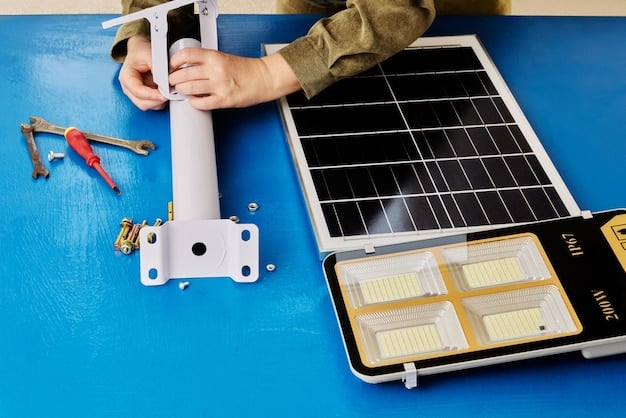Maximize Savings: Homeowners’ Guide to the 26% Solar Tax Credit

Homeowners can take advantage of the 26% federal tax credit for solar panel installation by ensuring their system is installed and operational before the credit changes, understanding eligibility requirements, and properly filing IRS Form 5695 with their tax return.
Are you a homeowner looking to reduce your carbon footprint and save money on energy bills? Investing in solar panels can be a smart move, and the federal government offers a significant incentive through the investment tax credit (ITC). Learn how can homeowners take advantage of the 26% federal tax credit for solar panel installation before it changes to maximize your savings.
Understanding the Federal Solar Tax Credit
The federal solar tax credit, also known as the investment tax credit (ITC), is a significant financial incentive offered by the U.S. government to encourage homeowners to adopt solar energy. It allows you to deduct a percentage of the cost of installing a solar energy system from your federal taxes, making solar power more affordable and accessible.
This credit has played a crucial role in driving the growth of the solar industry and reducing the nation’s reliance on fossil fuels. Understanding its mechanics and eligibility requirements is essential for any homeowner considering investing in solar.
What is the Investment Tax Credit (ITC)?
The ITC is a tax credit that applies to various types of renewable energy investments, with solar panel installations being a primary beneficiary. The credit is calculated as a percentage of the total cost of the solar system, including equipment, labor, and installation fees.
Initially set at 30%, the ITC has been gradually stepping down. It’s crucial to understand the current percentage and the timeline for future reductions.
Current Credit Percentage and Timeline
Currently, the ITC offers a 26% tax credit for solar systems installed between 2020 and 2022. For systems installed in 2023, the credit remains at 30%. However, the credit is scheduled to decrease to 22% for systems installed in 2024 and will drop to 10% for commercial projects and disappear altogether for residential projects starting in 2025 unless Congress acts to extend it.
This timeline emphasizes the urgency for homeowners to act now and take advantage of the current credit percentage before it diminishes.
- 📑 Review System Costs: Itemize all expenses related to your solar panel installation.
- 📅 Understand Deadlines: Be aware of the ITC step-down schedule to plan accordingly.
- 💰 Calculate Potential Savings: Estimate the tax credit amount based on your system cost and the applicable percentage.
In conclusion, the federal solar tax credit is a powerful tool for homeowners looking to invest in solar energy. By understanding the ITC, its current percentage, and the timeline for future reductions, you can make informed decisions and maximize your savings.
Eligibility Requirements for the 26% Tax Credit
To successfully claim the 26% federal tax credit for solar panel installation, homeowners must meet specific eligibility requirements set by the IRS. These requirements ensure that the credit is applied to qualified solar energy systems installed on qualifying properties. It’s important to carefully review these criteria to avoid any issues when filing your tax return.
Understanding these requirements upfront can help you ensure that your solar project aligns with the guidelines and maximizes your potential tax benefits.
Property Ownership and Location
The solar energy system must be installed on a property that you own and is located in the United States. This includes your primary residence or a second home. Renters are not eligible for the credit, as they do not own the property.
Additionally, the property must be located within the U.S. This excludes installations on properties located outside of the country.
Type of Solar Energy System
The tax credit applies to solar photovoltaic (PV) systems that generate electricity for your home. It also covers solar water heating systems that heat water for domestic use. The system must be new or being used for the first time.
Used or previously installed systems are not eligible for the credit. The purpose is to incentivize new solar installations and promote the growth of the solar industry.
System Installation and Operation
The solar energy system must be installed and operational during the tax year for which you are claiming the credit. This means the system must be fully functional and generating electricity or heating water by December 31 of the tax year.

Simply purchasing the system is not enough; it must be fully installed and actively contributing to your home’s energy needs.
- 🏡 Verify Property Ownership: Ensure the property is owned by the person claiming the credit.
- ☀️ Confirm System Type: Check that the system is a qualified solar PV or solar water heating system.
- ⚙️ Ensure Proper Installation: Make sure the system is installed and operational before the end of the tax year.
In conclusion, understanding the eligibility requirements for the 26% federal tax credit is crucial for homeowners. By ensuring that you meet these criteria, you can confidently claim the credit and maximize your savings on solar panel installation.
Step-by-Step Guide to Claiming the Tax Credit
Claiming the 26% federal tax credit for solar panel installation involves a straightforward process that requires accurate documentation and timely filing of the appropriate tax form. By following this step-by-step guide, homeowners can navigate the process with confidence and ensure they receive the tax credit they are entitled to.
This guide outlines the necessary steps, from gathering documentation to completing and submitting the required form, to help you successfully claim your solar tax credit.
Gathering Necessary Documentation
Before you begin the process of claiming the tax credit, it’s essential to gather all the necessary documentation. This includes receipts for the solar panel system, installation costs, and any related expenses. Keep these documents organized and readily accessible.
Having these documents on hand will make the filing process smoother and help you accurately calculate the amount of the tax credit.
Completing IRS Form 5695
To claim the solar tax credit, you must complete IRS Form 5695, titled “Residential Energy Credits.” This form is used to calculate and claim various residential energy credits, including the solar tax credit. Fill out the form accurately and completely, providing all required information.
Pay close attention to the instructions and ensure that you enter the correct amounts in the appropriate sections. Double-check your calculations to avoid errors.
Filing the Form with Your Tax Return
Once you have completed IRS Form 5695, you must file it with your federal tax return. This is typically done when you file your annual income taxes. Attach the form to your tax return and submit it according to the IRS instructions.

Make sure to file your tax return by the deadline to avoid any penalties or interest charges.
- 🧾 Organize Receipts: Collect and organize all receipts related to your solar panel installation.
- ✍️ Fill Out Form 5695: Complete IRS Form 5695 accurately and completely.
- 📤 File with Tax Return: Attach Form 5695 to your federal tax return and submit it on time.
In conclusion, claiming the 26% federal tax credit for solar panel installation requires careful documentation, accurate completion of IRS Form 5695, and timely filing with your tax return. By following these steps, you can successfully claim the credit and enjoy the financial benefits of going solar.
Maximizing Your Savings with Solar Incentives
Beyond the federal tax credit, numerous state and local incentives can further reduce the cost of solar panel installation and maximize your savings. These incentives may include rebates, tax exemptions, and performance-based incentives. Exploring and utilizing these additional benefits can make solar even more affordable and attractive.
Understanding the available incentives in your area can help you make informed decisions and optimize your investment in solar energy.
State and Local Rebates
Many states and local governments offer rebates to homeowners who install solar panels. These rebates can significantly offset the upfront cost of the system. Research the specific rebates available in your state and municipality.
Rebates may be offered as a lump sum payment or as a reduction in the system’s purchase price.
Tax Exemptions
Some states offer tax exemptions for solar panel installations. These exemptions may include property tax exemptions, which prevent your property taxes from increasing due to the added value of the solar system. They may also include sales tax exemptions on the purchase of solar equipment.
Tax exemptions can provide long-term savings and reduce the overall cost of owning a solar energy system.
Performance-Based Incentives
Performance-based incentives, also known as production-based incentives, provide payments based on the amount of electricity your solar panels generate. These incentives reward you for the actual energy production of your system, encouraging efficient and well-maintained solar installations.
These incentives can provide a steady stream of income and further enhance the financial benefits of going solar.
- 🔍 Research Local Incentives: Investigate state and local rebates, tax exemptions, and performance-based incentives.
- 📝 Understand Eligibility: Review the eligibility requirements for each incentive to ensure you qualify.
- 💰 Calculate Potential Savings: Estimate the savings you can achieve by combining the federal tax credit with state and local incentives.
In conclusion, maximizing your savings with solar incentives involves exploring and utilizing the various state and local programs available. By combining these incentives with the federal tax credit, you can significantly reduce the cost of solar panel installation and enjoy substantial long-term savings.
Potential Changes to the Federal Solar Tax Credit
As with any government incentive, the federal solar tax credit is subject to potential changes and modifications. It’s crucial for homeowners to stay informed about these potential changes and plan accordingly to maximize their benefits. Understanding the factors that could influence the tax credit and the potential implications can help you make timely and informed decisions.
Staying updated on legislative developments and industry trends can provide valuable insights and help you navigate any changes to the solar tax credit.
Legislative Updates and Extensions
The future of the federal solar tax credit depends on legislative decisions made by Congress. Efforts may be made to extend the credit beyond its current expiration date or modify its terms. Keep an eye on legislative updates and industry news to stay informed about any potential extensions or changes.
Contacting your elected officials and advocating for the continuation of the tax credit can also play a role in influencing legislative outcomes.
Impact of Policy Changes on Homeowners
Any changes to the federal solar tax credit can have a significant impact on homeowners considering solar panel installation. A reduction in the credit percentage or its expiration could increase the upfront cost of going solar, potentially making it less affordable for some homeowners.
Conversely, an extension or expansion of the credit could provide additional incentives and further reduce the cost of solar energy.
Planning Ahead for Solar Investments
Given the potential for changes to the federal solar tax credit, it’s essential to plan ahead for your solar investments. Consider the current credit percentage and timeline, as well as any potential changes that may be on the horizon. Factor these considerations into your decision-making process and timeline.
Acting sooner rather than later can help you take advantage of the current credit percentage before it potentially decreases or expires.
- 📰 Stay Informed: Monitor legislative updates and industry news regarding the federal solar tax credit.
- ⏳ Consider Timelines: Factor in potential changes to the tax credit when planning your solar investments.
- ✍️ Advocate for Solar: Contact your elected officials and support policies that promote solar energy.
In conclusion, being aware of potential changes to the federal solar tax credit is crucial for homeowners. By staying informed, planning ahead, and advocating for solar energy, you can maximize your benefits and make informed decisions about your solar investments.
Financing Options for Solar Panel Installation
Financing options can play a crucial role in making solar panel installation more accessible and affordable for homeowners. Various financing options are available, each with its own advantages and considerations. Understanding these options can help you choose the best approach for your financial situation and goals.
Exploring different financing options can unlock the financial benefits of solar energy without requiring a substantial upfront investment.
Solar Loans
Solar loans are a popular financing option that allows you to borrow money to pay for the solar panel system. The loan is typically repaid over a set period, with interest. Solar loans can be a suitable option if you want to own the system and take advantage of the federal tax credit and other incentives.
Compare interest rates, loan terms, and fees from different lenders to find the best deal.
Solar Leases
Solar leases are an alternative financing option where you lease the solar panel system from a company. You make monthly payments for the use of the system, but you do not own it. Solar leases can be a good option if you want to avoid the upfront cost of purchasing the system.
However, you may not be eligible for the federal tax credit or other incentives with a solar lease.
Power Purchase Agreements (PPAs)
Power Purchase Agreements (PPAs) are similar to solar leases, but instead of paying for the use of the system, you pay for the electricity it generates. You agree to purchase the electricity at a set rate, which is typically lower than the utility rate. PPAs can be an attractive option if you want to save money on electricity bills without owning the system.
Like solar leases, you may not be eligible for the federal tax credit or other incentives with a PPA.
- 🏦 Explore Loan Options: Research solar loans from different lenders and compare terms and interest rates.
- 🤝 Consider Leases and PPAs: Evaluate solar leases and PPAs to determine if they align with your financial goals.
- 📊 Compare Costs and Benefits: Compare the costs and benefits of each financing option to make an informed decision.
In conclusion, financing options can make solar panel installation more accessible for homeowners. By exploring solar loans, leases, and PPAs, you can find the best approach for your financial situation and enjoy the benefits of solar energy.
| Key Point | Brief Description |
|---|---|
| ☀️ Tax Credit Rate | Currently at 26%, scheduled to decrease in 2023/2024, act fast. |
| 🏡 Eligibility | Must own the property in the U.S. and have a new, operational system. |
| 📝 Claiming Process | Gather documents, complete IRS Form 5695, and file with your tax return. |
| 💰 Local Incentives | Explore rebates, tax exemptions, and performance-based incentives in your state. |
Frequently Asked Questions
▼
The federal solar tax credit, also known as the investment tax credit (ITC), allows homeowners to deduct a percentage of the cost of installing a solar energy system from their federal taxes.
▼
Homeowners who own the property where the solar system is installed and have a new and operational system are eligible for the tax credit, provided it is located in the United States.
▼
To claim the tax credit, you need to complete IRS Form 5695, titled “Residential Energy Credits,” and file it with your federal tax return.
▼
The tax credit is calculated based on the total cost of the solar system, including equipment, labor, and installation fees. Consult with a tax professional to be sure.
▼
Yes, many states and local governments offer additional incentives, such as rebates, tax exemptions, and performance-based incentives, that can further reduce the cost of solar panel installation.
Conclusion
As the federal tax credit for solar panel installation evolves, homeowners are encouraged to seize the present opportunity. By understanding the eligibility criteria, claiming procedures, and potential changes on the horizon, you can make informed decisions and **how can homeowners take advantage of the 26% federal tax credit for solar panel installation before it changes** to maximize their solar investment.





